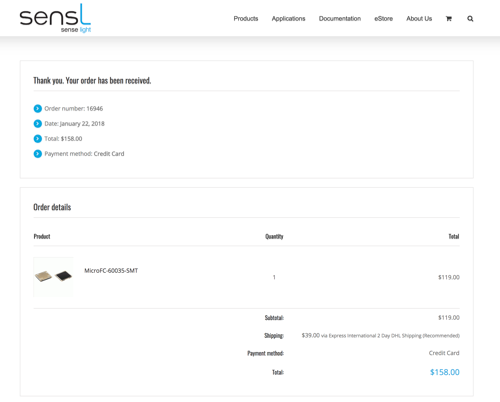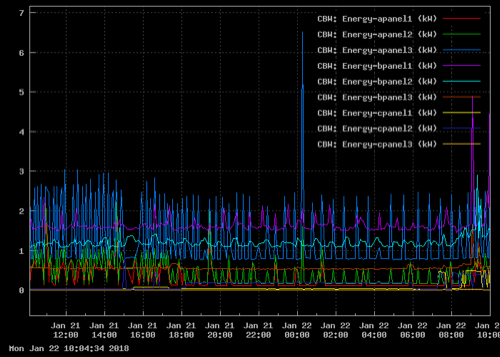Today was a good day for making progress on the muon detector. Daniel O'Connor from the Astronomy and Physics Branch at UH Hilo emailed me saying that my request for a scintillator came up in a meeting today, and that he would like more information so that they could make them and send them us for free. For the detector I need a 5*5*1 cm^3 plastic scintillator, and I said that eventually it would be great to make more detectors, but for now all I need is one. I am so happy that he got into contact with us as scintillators are hard to find and are expensive. Also, I order the Silicon Photomultiplier I needed today. Here is the order conformation:

Finally, for the muon detector, I found the code for the arduino nano. This code is made for a design slightly different then the one I am using, but it should work well, and I will take a better look at it tomorrow. Here it is:
| /* | |
| Desktop Muon Counter Arduino Code | |
| Questions? | |
| Spencer N. Axani | |
| saxani@mit.edu | |
| Requirements: | |
| 1. Adafruit GFX Library -- by Adafruit Version 1.0.2 | |
| 2. Adafruit SSD1306 -- by Adafruit Version 1.0.0 | |
| 3. Wire -- by Arduino Version 1.0.0 | |
| 4. OzOLED -- Version unknown, can be found on github. Or in the supplementary material. | |
| 5. SPI -- by Arduino Version 1.0.0 | |
| 6. TimerOne -- by Jesse Tane et al. Version 1.1.0 | |
| Simply un-zip the libraries.zip file and place the files into the Arduino/libraries folder on your machin | |
| */ | |
| #include <Adafruit_GFX.h> | |
| #include <Adafruit_SSD1306.h> | |
| #include <Wire.h> | |
| #include <OzOLED.h> | |
| #include <SPI.h> | |
| #include <TimerOne.h> | |
| const int OLED = 1; // Turn on/off the OLED [1,0] (Set to 0 to improve deadtime) | |
| const int LED = 1; // Turn on/off the LED delay [1,0] (Set to 0 to improve deadtime) | |
| //INTERUPT SETUP | |
| #define TIMER_INTERVAL 1000000 // Every 1,000,000 us the timer will update the clock on the OLED | |
| //OLED SETUP | |
| #define OLED_RESET 10 // A signal to this pin will reset the OLED screen | |
| Adafruit_SSD1306 display(OLED_RESET); | |
| //Linear regression parameters | |
| float x1,x2,x3,x4,x5,x6; | |
| float y1,y2,y3,y4,y5,y6; | |
| float Sx2y,Sylny,Sxy,Sxylny,Sy; | |
| float a, b; | |
| //Timing variables | |
| long measurement_t1 = 0L; // Time stamp | |
| long measurement_t2 = 0L; // Used to calculate deadtime of signal measurement | |
| long OLED_t1 = 0L; // Used to calcualte deadtime of OLED screen update | |
| long OLED_t2 = 0L; // Used to calcualte deadtime of OLED screen update | |
| long OLED_deadtime = 0L; // Tallies the total deadtime of the OLED screen between signal measurements | |
| long measurement_deadtime = 0L; | |
| long total_deadtime = 0L; | |
| const float TIME_INTERVAL = 5.8; // Using a prescaler of 4, the time between analogue samples is 5.8 us. | |
| String hist = "Initiallizing..."; // A histogram representing the relative number of photons seen by the SiPM | |
| const float SIGNAL_THRESHOLD = 80; // Signal threshold, measured from 0-1023. Measureing from 0 to 300mV. 70 corresponds to approximately 20 mV threshold. | |
| const int LED_PIN = 3; // The LED digital pin connections. | |
| long int count = -1L; // A tally of the number of muon counts observed | |
| float SiPM_voltage = 0; // This is the calculated pulse amplitude of the SiPM signal | |
| float signal_voltage = 0; // This is the measured signal amplitude from the pulse detector circuit | |
| const String current_count_str = "Total Count:"; | |
| const String runtime_str = "Run Time: "; | |
| const String rate_str = "Rate: "; | |
| const String pm = "+/-"; | |
| long int time = 0.; | |
| int seconds = 0.; | |
| int minutes = 0.; | |
| int hours = 0.; | |
| float stdev = 0.; | |
| float average = 0.; | |
| char tmp2[15]; | |
| char tmp[15]; | |
| String current_count; | |
| String runtime; | |
| String rate; | |
| void setup() { | |
| Serial.begin(9600); | |
| ADCSRA &= ~(bit (ADPS0) | bit (ADPS1) | bit (ADPS2)); // clear prescaler bits | |
| ADCSRA |= bit (ADPS1); // Set prescaler to 4 | |
| display.begin(SSD1306_SWITCHCAPVCC, 0x3C); // OLED screen | |
| display.clearDisplay(); | |
| if (OLED == 1){ | |
| display.setTextSize(1); | |
| display.setTextColor(WHITE); | |
| } | |
| pinMode(LED_PIN, OUTPUT); // Setup the LED pin to output | |
| Timer1.initialize(TIMER_INTERVAL); // Initialise timer 1 | |
| Timer1.attachInterrupt(timerIsr); // attach the ISR routine | |
| getTime(); | |
| } | |
| void loop() { | |
| while (1) { | |
| if (analogRead(A0) > SIGNAL_THRESHOLD) // If true, we have an event! | |
| { | |
| y2 = analogRead(A0); // Read analogue pin A0 five times. | |
| y3 = analogRead(A0); | |
| y4 = analogRead(A0); | |
| y5 = analogRead(A0); | |
| y6 = analogRead(A0); | |
| total_deadtime += measurement_deadtime + OLED_deadtime; // time_pulse == deadtime of previous measuremnet. time_oled == deadtime associated with updating clock. | |
| measurement_t1 = millis(); // Time stamp of event | |
| noInterrupts(); // Turn of the interupts, so that it doesn't update the OLED screen mid measuremnt | |
| x1 = 0; // This is the time of the first measurement: y1 | |
| x2 = x1 + TIME_INTERVAL + 0.5; // It takes 504ns to perform the IF statement | |
| x3 = x2 + TIME_INTERVAL; | |
| x4 = x3 + TIME_INTERVAL; | |
| x5 = x4 + TIME_INTERVAL; | |
| x6 = x5 + TIME_INTERVAL; | |
| digitalWrite(LED_PIN, HIGH); // Turn on the LED | |
| // Calculate the initial pulse amplitude. This is just a exponential regression fit. | |
| Sx2y = x2*x2*y2 + x3*x3*y3 + x4*x4*y4 + x5*x5*y5 + x6*x6*y6; | |
| Sylny = y2*log(y2) + y3*log(y3) + y4*log(y4) + y5*log(y5) + y6*log(y6); | |
| Sxy = x2*y2 + x3*y3 + x4*y4 + x5*y5 + x6*y6; | |
| Sxylny = x2*y2*log(y2) + x3*y3*log(y3) + x4*y4*log(y4) + x5*y5*log(y5) + x6*y6*log(y6); | |
| Sy = y2 + y3 + y4 + y5 + y6; | |
| a = (Sx2y*Sylny - Sxy*Sxylny) / (Sy*Sx2y - Sxy*Sxy); | |
| b = (Sy*Sxylny - Sxy*Sylny) / (Sy*Sx2y - Sxy*Sxy); | |
| y1 = exp(a); // y1 is the calculated amplitude of the triggering pulses at the time of the trigger. | |
| signal_voltage = y1 * 5./1023.; // Convert the measured value, y1 , to a voltage (0-1024 == 0-5V) | |
| count++; // Increment the number of counts | |
| float aa = -0.0000213241; // These numbers come from the calibration of the electronics. See Calibration section in paper. | |
| float bb = 0.0236566939; | |
| float cc = -(0.3378053306 + signal_voltage); | |
| SiPM_voltage = (-bb + sqrt(sq(bb) - 4*aa*cc))/(2*aa); | |
| if (count > 0){ | |
| Serial.println((String)count + " " + (String)measurement_t1 + " " + (String)signal_voltage + " " + (String)SiPM_voltage + " " + (String)(measurement_deadtime + OLED_deadtime)); | |
| } | |
| interrupts(); // Allow for interupts, to update OLED | |
| if (LED == 1){ | |
| delay(signal_voltage*500);} | |
| digitalWrite(LED_PIN, LOW); // Turn off the LED | |
| measurement_t2 = millis(); | |
| measurement_deadtime = measurement_t2 - measurement_t1; | |
| OLED_deadtime = 0; | |
| } | |
| } | |
| } | |
| //TIMER INTERUPT | |
| void timerIsr(){ | |
| interrupts(); | |
| if (OLED == 1){ | |
| getTime();} | |
| noInterrupts(); | |
| } | |
| //UPDATE OLED SCREEN. It takes approximately 33ms to run the getTime function | |
| void getTime(){ | |
| OLED_t1 = millis(); | |
| if (signal_voltage > 0.0) {hist = "-";}; | |
| if (signal_voltage > 0.2) {hist = "--";}; | |
| if (signal_voltage > 0.4) {hist = "---";}; | |
| if (signal_voltage > 0.6) {hist = "----";}; | |
| if (signal_voltage > 0.8) {hist = "-----";}; | |
| if (signal_voltage > 1.0) {hist = "------";}; | |
| if (signal_voltage > 1.2) {hist = "-------";}; | |
| if (signal_voltage > 1.4) {hist = "--------";}; | |
| if (signal_voltage > 1.6) {hist = "---------";}; | |
| if (signal_voltage > 1.8) {hist = "----------";}; | |
| if (signal_voltage > 2.0) {hist = "-----------";}; | |
| if (signal_voltage > 2.2) {hist = "------------";}; | |
| if (signal_voltage > 2.4) {hist = "-------------";}; | |
| if (signal_voltage > 2.6) {hist = "--------------";}; | |
| if (signal_voltage > 2.8) {hist = "---------------";}; | |
| if (signal_voltage > 3.0) {hist = "----------------";}; | |
| if (signal_voltage > 3.2) {hist = "-----------------";}; | |
| if (signal_voltage > 3.4) {hist = "------------------";}; | |
| if (signal_voltage > 3.6) {hist = "-------------------";}; | |
| if (signal_voltage > 3.8) {hist = "--------------------";}; | |
| display.setCursor(0, 0); | |
| time = millis() / 1000.; | |
| seconds = time % 60; | |
| minutes = time / 60 % 60; | |
| hours = time / 3600; | |
| stdev = sqrt(count) / (time-total_deadtime/1000.); | |
| average = (float)count / (time-total_deadtime/1000.); | |
| display.clearDisplay(); | |
| current_count = current_count_str + " " + count ; | |
| runtime = runtime_str + hours + ":" + minutes + ":" + seconds; | |
| dtostrf(average, 1, 3, tmp); | |
| if(stdev <= 0.001){ | |
| char a = 0.000; | |
| dtostrf(a, 1, 3, tmp2); | |
| } | |
| else{ | |
| dtostrf(stdev, 1, 3, tmp2); | |
| } | |
| rate = rate_str + tmp + " " + pm + " " + tmp2; | |
| display.println(current_count); | |
| display.println(runtime); | |
| display.println(hist); | |
| display.println(rate); | |
| display.display(); | |
| //Serial.println(rate); | |
| OLED_t2 = millis(); | |
| OLED_deadtime += (OLED_t2-OLED_t1); | |
| } |
Today, I also looked into the telemetry server for HI-SEAS a little bit more. Of course, I can't look at data or make graphs with data from the hab right now, as no one is up there. However, I did look at it with the solar panels at the elab. Here is what the graphs should look like:

Finally, Jackie Payne and I have been working on starting a coding club, and Mr. Ford approved our request today. Tomorrow we will meet with Mr. Halstead and discuss our plans.
Comments